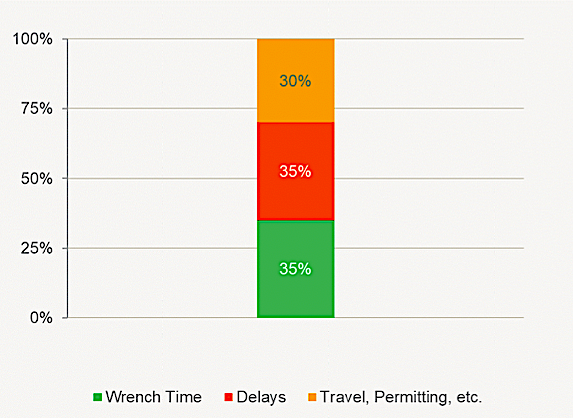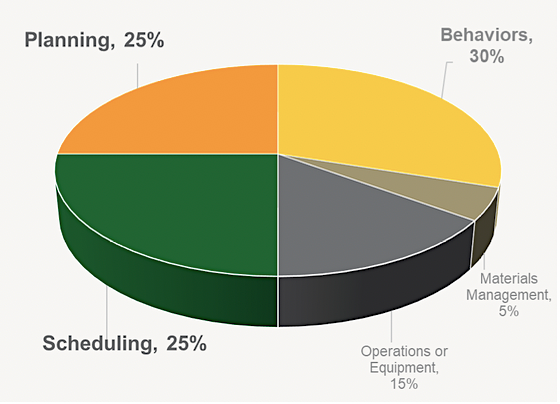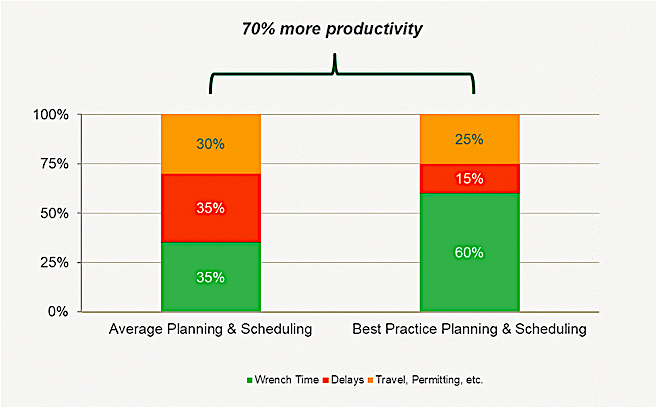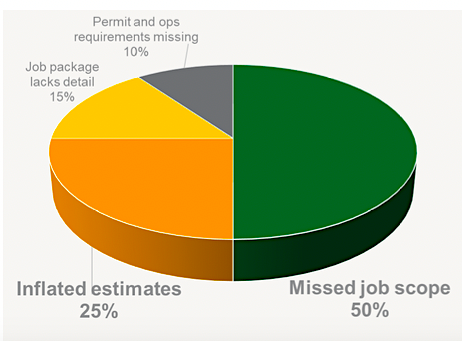From Peter Munson, CRE, CSSBB, CMRP, Manager
T.A. Cook (tacook.com)
Most organizations in asset-intensive industries fail to exceed 35% to 40% maintenance productivity, even with a fully staffed planning organization. This situation is so common that many maintenance professionals have accepted the idea that low “wrench time” is as good as it gets. That’s a terrible return on the planning investment and a gross underutilization of skilled maintenance professionals. As T.A. Cook’s Peter Munson explains in this article, plants can nearly double maintenance productivity if the organization commits to building and using better plans to avoid common delays.
A COSTLY STATUS QUO
At T.A. Cook, we spend a great deal of time with maintenance crews in the field. Our study data from process plants shows that travel, permitting, and preparation take up about 30% of a crew’s shift. Another 30% to 40% of their day is spent in working through preventable delays, leaving only about 35% of the shift for active maintenance (see Fig. 1).

Fig. 1. Typical maintenance productivity
As shown in Fig. 2, half of these costly delays stem from planning and scheduling. What is more, many of the other causes would also be improved through better planning and scheduling. Take the “behavior” category, for example. When consistently given a half day’s work peppered with delays, even the most diligent workers will soon lose the pep in their step. Put bluntly, 30% to 40% of your maintenance-labor spend is going up in smoke due to poor planning and scheduling.

Fig. 2. Root causes of work delays
Best-practice planning and scheduling is a very attainable goal. It does not require a completely new work management process or fancy technology tools. It just requires a higher level of precision in how you plan and schedule work. This relatively simple change can take your workforce from roughly 3.5 hours to 6 hours on tools in a 10-hr. shift. Without any additional spend, you can accomplish 70% more work (see Fig. 3).

Fig. 3. Improvement potential
UNDERSTANDING THE SHORTFALLS
First, it is important to understand the most common planning shortfalls (see Fig. 4).
In our studies, missed or unclear job scope is the culprit in half of all planning-caused delays. These are the gotchas that send crews back to the drawing board and have them waiting for parts, guidance, or help that was not anticipated in the job plan.
The second most common delay cause is inflated hours estimates. Planned hours are commonly double the actual required execution time, making it impossible to get efficient work or a realistic schedule. Inflated hours estimates cause delays because crews run out of work well before end of shift. It takes time and supervisor intervention to find and start fill-in work—if they get back on tools at all that day.
Third, job package detail and contents are usually not sufficient to keep crews at maximum productivity. All too often, the crew has to spend time hunting for information, looking up and printing forms, and so on.
Finally, more precise plans enable better scheduling and support more effective coordination with the Operations Department when it comes to permitting and equipment preparation. In this manner, good planning can help alleviate over half of all scheduling delays, as well.

Fig. 4. Planning-delay causes
THE ROAD TO IMPROVEMENT
The answer to these issues is not admonishing the planners to “Plan better.” Organizations that treat the situation simply as a “planner problem” fail to break out of this dead zone. Leadership must articulate a vision of “what good looks like” and commit as a team to making the change.
There is a chicken-and-egg problem at work here: Crews do not use job plans in the field because they don’t see much value in the current products. Planners don’t see much value in putting more detail into plans because crews do not use them. Additionally, planners don’t have time to improve plans because, when they aren’t conducting additional duties such as step-in supervising or working on special projects, they spend much of their day respective days answering questions from supervisors and crews in the field—because the plans aren’t detailed enough to execute without more information. Everyone believes that this vicious cycle is “as good as it gets,” even though things really could be much better.
Improvement, therefore, must start with management articulating a vision and committing to support it along the lines of the following statement:
“Detailed planning enables optimal maintenance work productivity by identifying and mitigating delays.
We are dedicated to creating and using quality plans to enable effective scheduling and quality work execution.”
The above statement, or one like it, must be agreed to by all key management stakeholders and should act as a guide when reviewing progress—and identifying backsliding—in the weeks and months ahead. With this statement as a guide, there are a number of critical actions that must be taken to enable improved planning.
1. Enable your planners to focus their efforts on planning. As noted above, many planners spend most of their day on tasks other than planning. Management must empower and require planners to shed other tasks and focus on planning future work – this is the only way to get out of the reactive mode and optimize productivity.
2. Create a reasonable program, including clear standards and tools. A relatively simple documentation of roles, responsibilities, and “the way we do things” should be the foundation of your process. Include standardized tools (e.g., checklists) to make planning efficient and repeatable.
3. Provide training for all participants in the planning process. Training on the new process includes more than just planners. Operations needs to be trained on the revised process and how to support it through improved notifications. Technicians need to be trained on the new job package contents and the expectation to use the plan and provide feedback on it.
4. Continue to monitor, guide, and support the change. The team should specify some metrics and recurring audit items to help monitor the improvement. These should be selected to ensure that the changes are having the desired impact and that they are being sustained.
INCLUDE DETAILS THAT MATTER
When job plans are used by crews as tools to avoid complications and delays, a different level of detail is required than many planners are used to providing today. This is a list of items for planners to address, based on the most common problems we see in the field.
- Location must be clearly indicated. Use text, attach plot plans, and/or include annotated photographs. Do not tell crews to “see Operations,” which commonly leads to misunderstandings or delays.
- Do not shortchange planning for scaffolding, insulation, and other support steps. We frequently see jobs delayed and rework required because there is no detail on these job steps. Ensure these requirements are spelled out, including drawings or annotated photographs.
- Review work history for lessons learned. Look at previous work orders, planner feedback forms, and talk to the last crew to work on this equipment in order to identify and mitigate the “gotchas” that cause delays.
- Identify potential issues with permitting and equipment preparation. In many plants, permitting and equipment preparation are owned by Operations and not touched by planners. These items frequently cause delays that could be mitigated in planning. Planners can highlight additional permitting requirements (for example, safety instrumented systems bypass forms) to help scheduling. Also, identify lengthy operations steps and known complications, such as isolation valves that are known to pass by.
- Keep an eye out for likely scope growth. Look beyond the basic issue for likely challenges, such as those corroded pipes around a flange or pump that were not in the notification, but need to be replaced. They should identify the corroded or caked bolt that may add several hours to the job. It takes time to look for these nasty surprises, but it has significant return in execution.
- Hours estimates should be the time for the average crew without buffer for unplanned complications. Hours should not be best case or provide a worst case buffer. The estimate should be what it takes the average crew on a normal day. Accept that some days it will go quicker and other days it may take much longer. These deviations will average out over time.
- Include all required forms, drawings, spec sheets, etc. Looking up and printing documents is a surprisingly common source of delays, especially when computer resources are limited or crews need to return from the field to find a document. These should be included in job packages to the maximum extent possible.
- List non-standard tools, materials, and PPE. Crews have to return to the shop far too often for forgotten items. Make a list and make its use mandatory.
- Use and continuously improve standard job plans to capture and build on the knowledge of the craft. No more re-planning jobs and re-learning the same lessons. The long text should have sufficient details so that a new technician can perform the job without additional questions or trial-and-error. The job package should include procedures, specifications, and reliability practices—especially for complex and critical jobs.
SUMMARY
As stated at the outset, you can nearly double your maintenance productivity—if you put the effort into implementing these improvements. While this doesn’t require a big investment, it does take sustained management attention and support to enable the improvements. Follow this simple roadmap and stick with it:
- Understand that management commitment and support is indispensable.
- Communicate a vision of what good looks like.
- Align stakeholders.
- Create a reasonable program, complete with procedures and checklists.
- Provide training and set expectations for all stakeholders.
- Give planners time to get into the details
- Tidy up the plumbing around planning. Start with good notifications; use the improved planning details to drive better scheduling; and ensure plans are followed during execution.
FOR MORE INFORMATION ON THIS TOPIC
CLICK HERE TO SEE PETER MUNSON’S WEBINAR
“PLANNING TO FAIL”
AND/OR VISIT
tacook.com/en/expertise/reliability-management/



